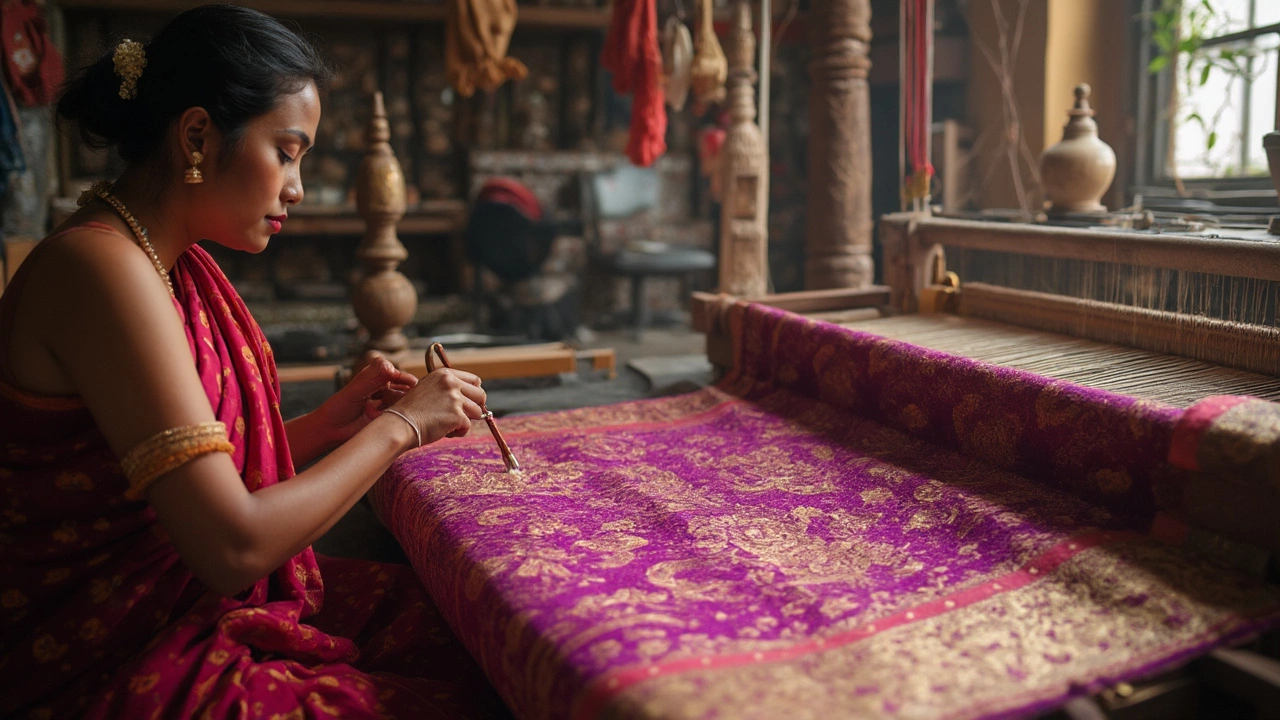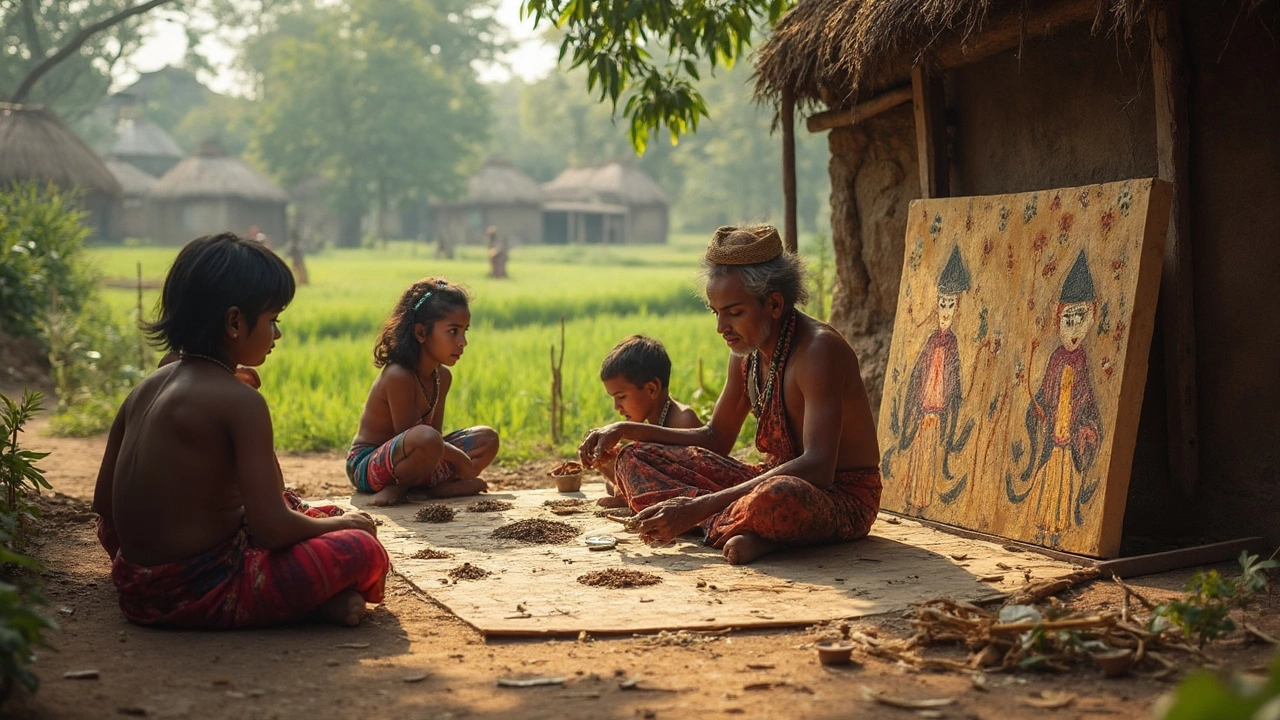When you think of Maharashtra, its bustling cities and vibrant festivals might come to mind. But the state is also home to some fascinating traditional handicrafts that showcase its cultural richness and skilled artisans. Like, have you ever heard of Paithani sarees? These luxury silk sarees, from the town of Paithan, are famous for their rich colors and intricate floral and bird motifs. They’re not just attire, they’re art pieces handed down through generations.
Another gem is the Warli paintings. Imagine stories told with just white pigment on mud walls. Coming from the Warli tribe, these paintings are like Maharashtra's doodles on life, capturing harvests, dances, and everyday life in simple yet striking designs. They’re a visual storytelling medium as cool and relatable as sketching in a diary!
- The Legendary Paithani Sarees
- Breathtaking Warli Paintings
- Kolhapuri Chappals: A Step into Tradition
- Intricate Bidriware Craft
- The Unique Art of Sawantwadi Toys
- Exquisite Aurangabad Himroo
The Legendary Paithani Sarees
Paithani sarees, the pride of Maharashtra, come from the ancient town of Paithan in Aurangabad. They're like the Rolls Royce of sarees in India, known for their luxurious silk fabric and intricate details. Each saree is a labor of love, often taking months to make, all thanks to its carefully woven motifs and rich colors.
What makes Paithani stand out are the peacock and lotus designs, along with vibrant color palettes that shimmer in shades of gold and silver. And the Maharashtra art doesn’t stop at beauty; these sarees are also cleverly engineered with a distinct feature called the 'kath' border. This reversible border means you can wear a Paithani inside out, and it’ll still look perfect!
These sarees have roots going back to the Satavahana dynasty, around 200 BCE, and were cherished by royalty and traders alike. They were even bartered as precious as gold back in the day. Isn't that something?
| Fact | Description |
|---|---|
| Origin | Paithan, Maharashtra |
| Main Colors | Vibrant shades of purple, green, red, yellow |
| Main Motifs | Peacocks, Lotuses, Hamsa (swan) |
When it comes to buying an authentic Paithani saree, look for the silk’s sheen and examine the weave. These sarees don’t come cheap, but a true Paithani is a wise investment, offering both cultural richness and elegance. It's not just a cloth; it’s a piece of heritage that you carry. Plus, gifting a Paithani is like handing someone a piece of Indian handicrafts history, wrapped in grace.
If you're visiting Maharashtra, try making a trip to Paithan itself. You might just find a master weaver who’ll give you a glimpse into the magic of turning threads into this timeless art.
Breathtaking Warli Paintings
The Warli paintings are more than just art; they're history splashed on walls. Emerging from the tribal communities of Maharashtra, these art pieces turn humble mud walls into canvases for vibrant storytelling. The Warli tribe, particularly from the Thane district, has kept this tradition alive, using simple geometric shapes like circles, triangles, and lines to craft intricate scenes.
What’s cool about Warli paintings is their simplicity. They mainly use white pigment on an earthy red background, which is made from rice flour mixed with water. Traditionally, women artists would create these scenes to celebrate harvests or marriages, turning homes into galleries of cultural narration.
In these paintings, you’ll often see themes of farming, hunting, and festivals, with figures depicting the community’s daily routines. This art form doesn’t just depict life events; it’s also about nature, animals, and the harmony of life. Despite their seemingly basic style, Warli paintings communicate profound stories and emotions. You could say they turn the everyday into extraordinary tales.
| Key Elements | Details |
|---|---|
| Colors Used | White on Red |
| Main Themes | Community life, Nature, Dance |
In recent years, Warli art has made its way onto everything from canvas boards to clothing, gaining popularity not just in India but worldwide. So, if you’re ever in Maharashtra, or spot a Warli painting somewhere, take a moment. You’re not just looking at lines and shapes; you’re witnessing a legacy that’s been passed down through generations.
Kolhapuri Chappals: A Step into Tradition
Picture this: a pair of Kolhapuri chappals, crafted with such precision and detail that they aren't just footwear, they're pieces of art. Straight from the heart of Maharashtra, these leather sandals have been a symbol of tradition and style for centuries. If you ever thought footwear couldn’t be conversational, think again!
The magic of Kolhapuri chappals begins with their making. These chappals are entirely handcrafted by skilled artisans in the town of Kolhapur. Made mainly from leather, they're often tanned using vegetable dyes. The artisans meticulously cut and shape each piece, ensuring every pair is unique yet reliable in comfort. And no nails! Instead, the stitching holds it all together, showcasing the craftsmen's skill.
Why do people adore these shoes? It's partly their durability but also the style that seems to fit with anything—traditional or modern. Plus, they’re eco-friendly since no harsh chemicals are used in their production. Fun fact: Kolhapuri chappals take about six weeks to make a single pair! This slow craftmanship is part of their charm.
A famous quote from Afroz Shah, a Tikar-gram based maker, highlights the effort that goes into each pair.
"Every Kolhapuri chappal is a proud homage to our history, something your feet don’t just wear but speak through."
Despite their long history, they’re still a hit at fashion ramp walks and retail stores globally. Here’s a simple tip for keeping your Kolhapuris in great condition: regularly apply a little leather conditioner to maintain their shine and flexibility. This keeps them looking snazzy while extending their lifespan.
If you’re hunting for authentic Indian handicrafts, getting a pair of traditional Kolhapuri chappals is like owning a piece of cultural art you can wear.

Intricate Bidriware Craft
Ever seen metal that looks like it's been kissed by the moon? That's the charm of Bidriware, a craft born in the small town of Bidar but flourishing in parts of Maharashtra. It's a metalworking art that stands out due to its striking black surface marbled with delicate, magical-looking silver inlay work. This contrast of colors is what makes it so eye-catching and unique.
Bidriware isn't just about aesthetics but also about technique. The process begins with creating an alloy of zinc and copper. Skilled artisans then shape everything from vases to hookah bases and tables. Next up is the inlay, where meticulously carved designs are filled with pure silver. Imagine the patience and precision that goes into each piece! Finally, the distinctive black color is achieved by treating the surface with a special soil native to Bidar, known for its unique properties. This is what turns the metallic hue into that deep black tone you're likely to fall in love with.
Looking to differentiate a genuine Bidriware piece from a wannabe? Real Bidriware will have a smooth, almost velvety touch on the black areas, while the silver work will shimmer like stars on a clear night.
This craft is more than eye-candy; it's a part of India's cultural fabric. Want to grab a piece for yourself? These days, Maharashtra's art markets and exhibitions often showcase this beautiful craft, making it easier for you to own a piece of history. Whether you choose a classic vase or a decorative plate, each item is a nod to the artistic mastery and cultural legacy of the region.
If you ever get a chance to visit a workshop or meet the artisans, don't pass it up. There's nothing quite like seeing these masters in action, transforming humble materials into timeless pieces of art. So next time you're exploring the art scene in Maharashtra, keep an eye out for these stunning artforms that marry tradition with exquisite craftsmanship.
The Unique Art of Sawantwadi Toys
Ever played with toys that double as art? That's what you'll find with Sawantwadi toys. Crafted in the quaint town of Sawantwadi in Maharashtra, these handcrafted toys have a charm that takes you back to childhood, yet they are elegant enough for collectors. Made from naturally sourced materials, these toys are typically carved out of wood from the locally abundant Pangara tree. The process of making these toys involves a combination of turning, carving, and intricate hand-painting.
The creators, mainly from the Chitari community, are artists who pass down their skills through generations. It's like storytelling in 3D form, with the painted figurines depicting everything from traditional Maharashtrian culture to national history. A typical Sawantwadi chess set, for example, isn't just a game—it's an intricate piece featuring hand-painted kings and queens inspired by Maratha folklore.
What's cool about Sawantwadi toys today is how they bridge the old with the new. As the demand for these crafts grows, artisans are combining traditional techniques with modern themes, like cartoon characters or movie icons, to appeal to a wider audience without losing their cultural roots.
Why are these toys significant? They aren't just about looking pretty. They hold historical and cultural value, reflecting Maharashtra's artistry and offering a livelihood to many families in the area. Plus, buying these toys supports local crafts, and who doesn't love owning something that's lovingly handmade and not mass-produced?
- Made from locally sourced wood
- Carved and painted by hand
- Reflect Maharashtra’s traditional and cultural themes
- Each piece is unique and collectible
If you ever visit Maharashtra, checking out these toys is a hands-on way to connect with the state's artistic heritage. They make great gifts and even better souvenirs, serving as a colorful reminder of the skilled craftsmanship and vibrant culture of Maharashtra.
Exquisite Aurangabad Himroo
So, ever heard of Himroo fabric? It’s like the Prada of ancient textiles, coming straight from Aurangabad. This craft dates back to, and get this, the 14th century! It’s a silk and cotton blend, which makes it not just gorgeous but also comfy. The designs are woven into the fabric, often using traditional patterns that were once fit for royals.
Legend has it that Himroo is actually a local version of the Persian fabric ‘Khimar.’ The Mughal rulers, and even affluent families, couldn’t get enough of it. And today, artisans in Aurangabad keep this art alive, preserving the detailed patterns that make these fabrics so unique.
What really makes Himroo stand out are its intricate designs. You’ll find motifs inspired by flowers, animals, and Arabic architecture. And, unlike mass-produced textiles, Himroo fabric is all about storytelling through design. That’s a theme you'll notice in many Maharashtra crafts.
If you’re ever in Maharashtra, you might even witness artisans at their looms, working diligently to create each piece. It’s not just about the finished product; it’s about history woven into every strand. These fabric pieces were often considered family heirlooms, passed down like cherished secrets.
Today, Himroo is not just limited to sarees. You’ll find it in shawls, bedspreads, and even wall hangings. Imagine hanging a work of art with a story above your couch. It’s pretty cool how these crafts keep evolving, yet stay true to their roots, right?
